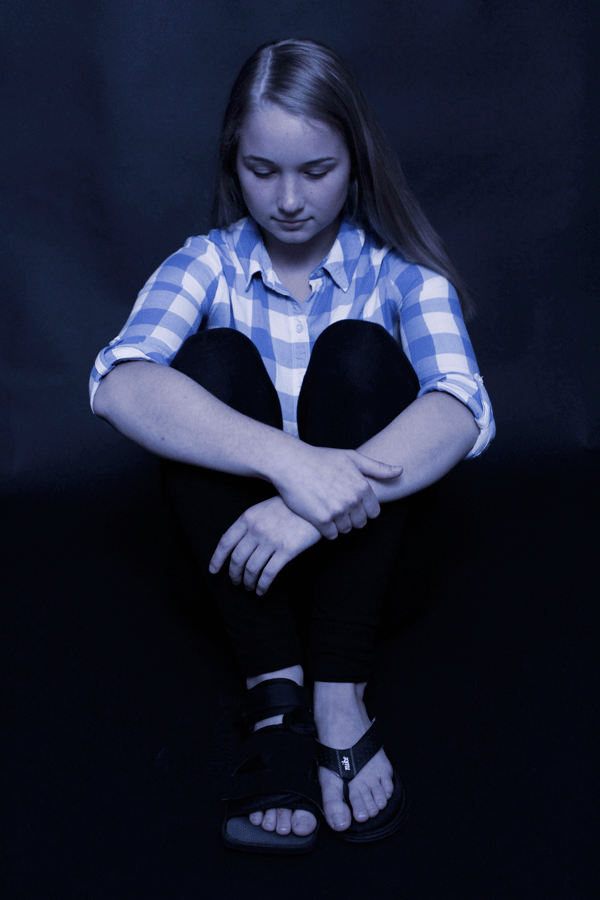Once in a Blue Moon
1. Not very often. 2. Rarely. 3. Almost never happening.
For many, “that will never happen to me” is a common occurrence–the denial that physical, mental and emotional ailments can impact one’s family, one’s friends or oneself. That is what senior Skyler Searle always thought when she passed the room of mentally disabled students at school, or those unable to participate in the normal, everyday activities of a kindergartener and first grader. However, it wasn’t until her second year in elementary school that she was hit with a disease more rare than those seen in the special education classes, and she was forced to live in a lifestyle different than those around her.
“She wasn’t able to play with her friends,” Tracy Searle, Searle’s mother, said. “It made her grow up faster and she had to get used to people always looking at her strangely.”
Being in a wheelchair at such a young age as eight is difficult for any kid. But as a girl that was in love with cheerleading and being active with all the rest of the “normal” eight-year olds, it was hard for Searle to grasp the reasons behind the hindrances she faced. While wheeling herself from classroom to classroom and putting her best effort into enjoying activities normally, she was suffering from the diagnosis of Henoch-Schönlein Purpura (HSP). Her legs were abnormally swollen due to inflammation and bleeding within small blood vessels in her body.
“I did not understand why I was in a wheelchair at this age,” Searle said. “But I knew that through its rarity, I received different treatment in comparison to others.”
Although she was eventually able to leave the wheelchair, Searle went through elementary school with various problems concerning her body, and never quite understood the disease or if there was something more to the symptoms that were constantly affecting her.
Throughout most of her middle school years, Searle was able to participate in a sport like many of her friends. While heavily involved in cheer, she competed nationally through different teams and was able to perform tumbling and stunts normally, having only minor physical incidents. However, after repeated accidents in this sport, she was finally taken to the doctor to seek out more information and verify if these problems were merely symptoms from HSP, which she had been dealing with for several years now. There, after many tests that involved numerous needle prickings and blood samples, she was diagnosed with Ehlers-Danlos Syndrome (EDS), which explained her being hurt easily through physical activity.
The genetic disease that impacted very few people in her family is caused by unstable tissues, which lead to organ and joint pain in the body. When she discovered this, Searle was a bit more limited in terms of physical activity, yet was still able to participate, simply with more caution than before.
“By this time in my life, [myself] and those around me were pretty accustomed to my medical problems,” Searle said. “It wasn’t out of the ordinary when I walked into class with a newly casted wrist, arm sling or crutches.”
The news her family received, though degrading in terms of healthiness, was a relief as more answers were revealed towards Searle’s constant pain.
It wasn’t until six months later, as the physical illnesses continued, that Searle found herself passing out easily and fainting on a frequent basis. With recurring visits to various doctors in order to gain more details on the symptoms she was having and the proper medicine needed for them, Searle grew more nervous. It was difficult to find a doctor that understood her problems and could diagnose them based on the explanations and blood samples Searle gave. But after frequent days off of school, the leaving of her cheer team and many clinic visits, she found her current doctor who was able to further pinpoint the source of the problems.
“If we weren’t comfortable with an answer, we would search for a different doctor that her and I could trust,” Searle’s mom said. “[We wanted] a second opinion to feel comfortable with the diagnosis we received.”
The inclusion of Postural orthostatic tachycardia Syndrome (POTS) as her third disease was, again, a relief as it provided an explanation for the frequent fainting spells Searle encountered. When she woke up from short naps and stood, the immediate fuzziness and weakening control within her body was a result of reduced blood volume, making quick and sudden movements unbearable for the already fragile organs and bones, as explained by one doctor. In addition, the clarification provided Searle with medicine that, today, continues to help with her weak blood vessels and easily irritated body.
“As a parent, it increased my worries a lot,” Searle’s mom said. “And it was hard finding the line between restricting her and letting her go live her life.”
Despite her growing up with many problems concerning her body and health, the diseases Searle has are rare and lead to more caution in her day-to-day life. Unlike many other people, she cannot participate in physical activity with the amount of effort needed, and is easily hurt.
“When I was stuck in a car crash with friends, I was the only one affected, receiving a concussion that lasted for weeks, while the others were barely scratched,” Searle said.
Similarly, her friend accidentally broke Searle’s toe while lightly pushing Searle’s leg off of a couch. These are all examples of how today, the uniqueness of this disease affects Searle’s life in a way that, according to Dysautonomia International, only .3 percent of Americans relate to. Although it may have a negative impact on her life physically, undergoing these diseases taught her to build up self-esteem and inspired her future career path.
After hundreds of doctor, pediatrician and physical therapy visits, she gained an interest in the medical field and is planning on pursuing a degree where she can help others that face similar situations, both physically and mentally.
“I do not look down on the fact that I suffer with the rare diseases of POTS and EDS, and will continue to for most of my life,” Searle said. “[Instead], I deal with my body’s issues and try to use my experience to impact those around me positively.”
Having a rare, medical problem is a challenge, but Searle took from it many life lessons, and learned to not let it define herself.


